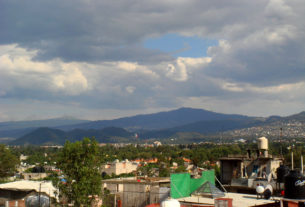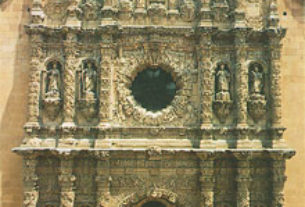All my life, I have been a coward about death and dying. It’s all so unsanitary somehow; so negative; so threatening. Better to turn your head, tune out suffering, and tune in to the happy positive life of eternal youth that is the birthright of every television-watching white kid who grew up in the U.S. the ’50s. Hand over the unpleasantness to a nursing home, and a funeral director. Put it out of your mind.
All that stuff is different in Mexico (and most of the rest of the world). Death and dying, like living, are family affairs. Although the demands of industrialization and the resultant breakdown of family structure are making inroads into the traditional ways, most families still house and care for their elderly at home, where the vast majority of nonviolent deaths occur. What we euphemistically refer to as “the remains” lie in state in the house of the bereaved family for several days, the focus of family and neighborhood attention. Traditionally, the gravestone is erected about a week after burial. It is not until this ceremony that closure is achieved, but even this is not “adios”; only “hasta el dia”: El Dia de Muertos, the Day of The Dead.
While the actual Dia is November 2, Oaxacans celebrate for about a week beforehand. Church, state, culture and tradition combine to create a fiesta that is both rich and enriching. The plaza in front of the Cathedral is filled with sand sculptures and wooden skeletons. Booths sell candy skulls and Halloween masks, as well as food and craftworks. Flowers in various shades of orange, from red to yellow, flood into the local markets along with the seasonal harvest of pumpkins and squash. Bakeries cut back on their usual fare to produce “pan de yema”, a mildly sweetened egg bread. Candle makers and chocolate blenders shift into overtime.
Altars with pictures of the dead are erected and decorated in people’s homes, and furnished with food and drink for the spirits of the departed, who will come to visit. Students at the various university branches and functionaries at the Cultural Institute vie with one another to see who can put together the most elaborate structures. The city erects a giant altar outside the post office.
There are other places in Mexico whose traditions and elaborateness are said to exceed Oaxaca’s. However, Oaxaca’s accessibility and an infrastructure of inexpensive and comfortable tourist accommodations are inspiring an increasing number of tour operators to choose Oaxaca as a Day of the Dead destination.
Oaxaca has grown in recent years to encompass what used to be separate outlying villages. Most of these villages had their own cemeteries, usually relatively small and modest in their appointments. The larger, more elaborate (richer) cemeteries in Oaxaca proper and in the suburb of Xoxocatlan garner most of the tour buses, and leave the others relatively undisturbed by crowds of flashbulb-popping foreigners.
San Felipe del Agua, where I lived for the first year after I arrived, used to be out of town. Now an affluent neighborhood, with an incredible growth rate and lots of foreigners in residence, its chief claim to fame historically is that most of the water consumed in Oaxaca originates in San Felipe’s springs. A poor peasant community for most of its history, its panteon (cemetery) is small, unpretentious, and minimally maintained. Strolling by on walks through the neighborhood and observing its humble appearance left me unprepared for my first Day of the Dead there.
Arriving after dark, I found the street around the cemetery entrance lined with makeshift restaurants. A brass band was playing. Outside the graveyard, everyone was smiling, joking, having a good time. Inside, the local Catholic church choir, singing hymns, was followed by Ranchero music, interspersed with speeches by local bigwigs. Candles were burning, and graves were decorated with flowers, bread, mezcal and candy skulls. Folks were hanging out and socializing. This normally desolate graveyard had been transformed into a magic wonderland of softly lighted good spirits.
Last year (my second), I went back to San Felipe, even though I no longer live there. This time I did some visiting with folks I had come to know, and made a discovery that will keep me coming back as long as I am here: there is a U.S. expatriate buried here, and no one remains to decorate his grave and sit with his spirit.
According to his tombstone he was a poet, teacher, environmentalist and historian who passed away after 20 years in the village, many years before I came here to live. Although he still lived when I first visited here in 1973, we did not meet. Nonetheless, I felt an immediate connection, not so much to him, as to the whole spirit of El Dia; a way to a different consciousness about this central event in the year’s passage.
Next year, I will return to the panteon de San Felipe with flowers, chocolate, bread and sugar skulls. There will be candles, and mezcal. Stop by for a drink and a chat.



